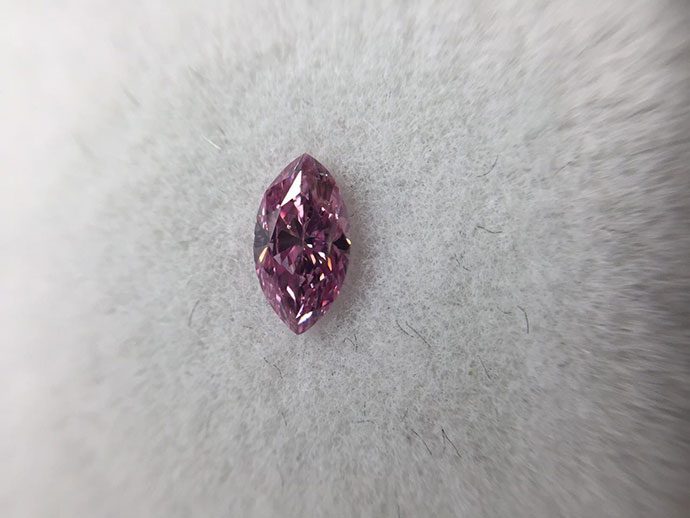
Diamonds are a very personalised type of jewellery. Some people want a princess cut, and some want pear shaped. Some people are specific in the amount of carats they want, while others care about clarity. And when you add colour into the mix, things can get even more confusing. Here are some things to consider when looking at pink diamonds.
What are pink diamonds?
Pink diamonds belong to the niche ‘coloured diamonds’ family. Regular diamonds are colourless, however coloured diamonds come in a variety of hues. The most commonly known are brown and yellow diamonds. But you can also get diamonds in red, blue, purple and pink.
Pink is one of the rarest colours you can get, and while causes most of the other colours is well known, the reason why pink diamonds are pink, remains somewhat of a mystery. In fact, pink diamonds account for less than 0.02 per cent of the total carats of rough diamonds produced. It is thought that extreme pressure and heat distorts the crystal lattice of some stones so they absorb the light in a certain way, giving them a pink colour.
There are three important elements to understand when considering pink diamonds:
- Hue – the dominant colour in the diamond.
- Tone – the amount of light or darkness in the diamond.
- Saturation – the strength of the hue.
Also, when it comes to pink diamonds, in terms of grading and value, the intensity of the colour is often more important than the other three C’s (clarity, cut and carat).

The Argyle Diamond Mine
Based in the Kimberley region of Western Australia, the Argyle Diamond Mine produces 95 per cent of the world’s pink diamond supply. The argyle diamond is known for its spectacular colour and its investment potential.
Generally, argyle pink diamonds value increase by 20% each year. This is for a variety of reasons, including:
- Rarity – it’s a rare and exclusive item.
- Demand – the demand for the argyle pink diamond far outweighs supply.
- Scarcity – the number of pink diamonds is decreasing.
Some experts argue the distinct colour of argyle pink diamonds is thanks to the specific environs of the Kimberleys, claiming the resulting mineral caused by the deformation in the atomic structure of the region produces the pinkness.
The colour
Importantly, the colour composition of pink diamonds is usually a combination of two, sometimes three, colours. The spectrum generally includes brown, purple and orange. There are five main colour categories:
- Purplish pink
- Pink
- Rose pink
- Pink champagne
- Blue violet
At the top end of the scale there is also purplish red, and red.
Of course, all colours need to be graded. This grading will be on the diamond certificate, and it measures the intensity of the colour. Colour intensities for pink diamonds include faint, very light, light, fancy light, fancy, fancy intense, fancy deep and fancy vivid.
Importantly, don’t be fooled by treated pink diamonds. White or off-colour diamonds can be treated to create coloured diamonds, for example using high pressure, high temperature treatment. Jewellers are ethically obliged to disclose if a diamond has been treated, so if you want the real thing, make sure you check the certification.
However, these processes can be a great option for people who want a pink diamond, but don’t have the budget for it.
Pricing
The pricing of all diamonds is generally evaluated by the four Cs – carat, colour, clarity and cut. While there are other variables affecting the pricing of a diamond, these four classifications are the main elements that can give you an indication of price. This pricing system was instigated by the Gemological Institute of America.
Importantly however, this system was invented mainly for grading colourless diamonds. When it comes to the coloured family, the emphasis is more strongly placed on colour. For example, a pure vivid pink one carat diamond may cost more than a fancy pink diamond weighing one carat, or sometimes even two carats. And to make it even more confusing, the secondary colour also comes into play when price is determined. A rarer secondary colour obviously pushes the price up. TO keep things simple, just remember with pink diamonds, it all comes down to colour and how saturated it is. The more intense the colour, the more expensive the diamond.
However, the other three Cs still play an important role in pricing.
When it comes to carat (the weight of the diamond), the more carats there are, the more expensive it’s going to be. Likewise, greater the clarity of the diamond equates to more money. And as always, the cut of the diamond is of imperative importance. The quality of the cut, and how the diamond reflects the light, is sure to increase the value of your sparkler.
by Australian Diamond Brokers : April 11th 2016 Come visit our store or browse our website to find out more.
